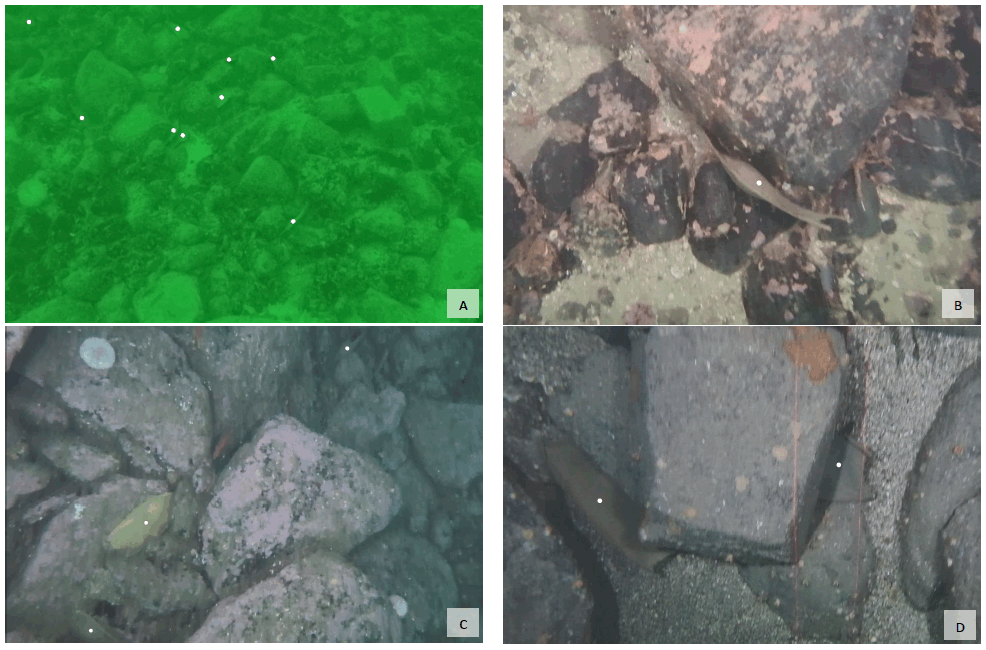Flapper Skate protection: NatureScot advice to the Scottish Government
This document contains NatureScot's statutory conservation advice to Scottish Ministers regarding the protection of flapper skate eggs in the Inner Sound of Skye. This advice was considered by Ministers and contributed to their decision to designate the Red Rocks and Longay Urgent MPA.
Annex 1 Flapper skate habitat use and description of egg-laying habitat
Flapper skate habitat use
Eggs
It is likely that the eggs will be on the seabed for up to 18 months before hatching. They are large and relatively fragile. The evidence to date highlights a habitat preference for boulder and cobble slope of depths between 25 -50 m (further details and photographs can be seen in Figure 1). The eggs are located in crevices between the boulders which likely prevent them being moved away from optimum conditions for development and survival. It is this habitat we have termed egg-laying habitat or egg nursery. There is deeper water adjacent to the egg-laying habitat, which is known to be a habitat preference for the adults in the Loch Sunart to Sound of Jura MPA. The Red Rocks location has been used for a minimum of 2 years, evidenced by different stages of egg development present and that skate eggs take 18 months to hatch. It is possible that all the eggs observed were laid by the same female visiting the site on multiple occasions but the volume of eggs observed suggests that a number of females are using the same egg nursery. Ongoing DNA analysis of the eggs will shed more light on this topic.
Juveniles
Our understanding of juvenile flapper skate habitat preference is limited. It is unclear if recently hatched juveniles remain where they hatch for some time or move to other habitats quickly. Anecdotal information for fishermen suggests that juvenile flapper skate are caught as bycatch in Nephrops trawls, and so therefore utilise muddy habitats. This suggests that there is movement away from egg-laying habitat.
Adults
Archival tagging of flapper skate has shown that adult flapper skate spend much of their time in water between 100-200 m deep (Neat et al. 2015[4], Thorburn et al. 2018[5]). However more recent work shows that flapper skate do use all depths available to them (Thorburn et al., In prep), and they move to shallower water to lay eggs. There is deeper water adjacent to the egg–laying habitat in the Inner Sound which adults may also use.
Egg-laying habitat description
From observations to date (primarily DDV footage from the EMFF survey project with follow-up diver sampling at the Inner Sound location), flapper skate lay their eggs in crevices between boulders in water depths between ~25-50 m, potentially with a preference for the outer margins of the habitat, accessible to adjacent deeper waters.
Cobbles and pockets of mixed sediments may also be present but generally appear to form a smaller component of the substrates.
Egg laying appears to take place below the infralittoral kelp zone. However, this may reflect the source of existing, drop-down camera-derived records with diver searches required in nearby, shallower waters beneath any algal canopy to determine upper depth limits which may vary according to geographic location. Diving activity to date has focussed on circalittoral boulder reef habitat where eggs were first reported by scallop divers.
Screenshots from the EMFF drop-down video footage showing egg-laying habitat with eggs are provided overleaf (Figure 1). [Redacted]. The footage was recorded as the camera descended (below the kelp zone at ~25 m) but the lights were not turned on until the frame got to the seabed (~32 m) by which time it had cleared the boulder slope and no more eggs were apparent. The DDV analyses did not include this part of the footage with the DDV 'run' deemed to commence once at the seabed.
Eight eggs were observed following review of 2019 footage [Redacted]. One or two of the observations were of low confidence but there were more eggs present than the four noted in the 2019 project report. Similarly, a greater number of eggs were apparent on the single runs in Shetland [Redacted] and Loch Craignish / Sound of Jura [Redacted] where reported in the 2019 project report.

Figure 2. [Redacted]
Contact
Email: marine_conservation@gov.scot
There is a problem
Thanks for your feedback